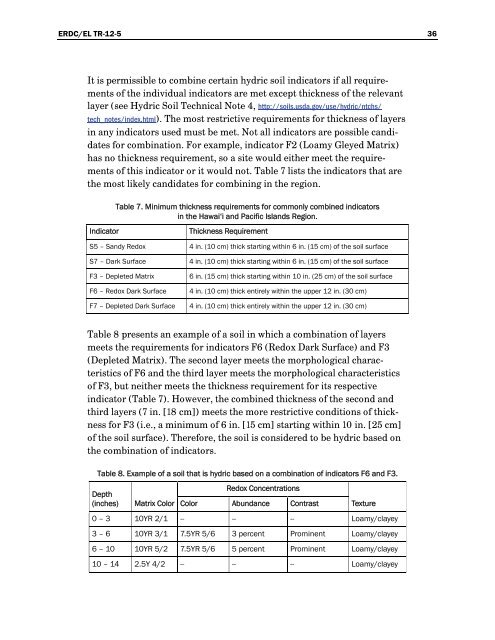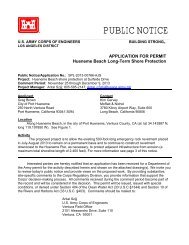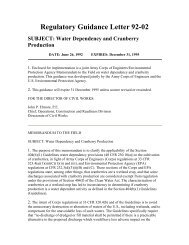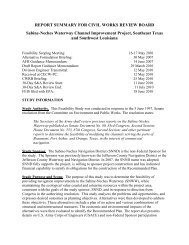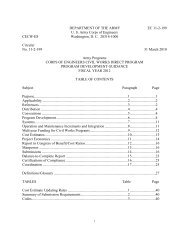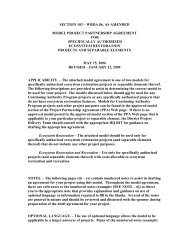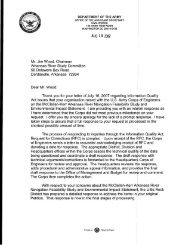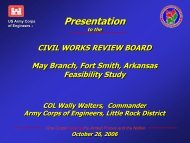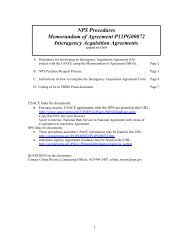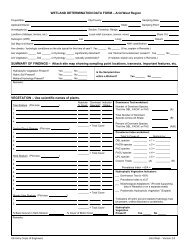Hawaii and the Pacific Islands - U.S. Army Corps of Engineers
Hawaii and the Pacific Islands - U.S. Army Corps of Engineers
Hawaii and the Pacific Islands - U.S. Army Corps of Engineers
You also want an ePaper? Increase the reach of your titles
YUMPU automatically turns print PDFs into web optimized ePapers that Google loves.
ERDC/EL TR-12-5 36It is permissible to combine certain hydric soil indicators if all requirements<strong>of</strong> <strong>the</strong> individual indicators are met except thickness <strong>of</strong> <strong>the</strong> relevantlayer (see Hydric Soil Technical Note 4, http://soils.usda.gov/use/hydric/ntchs/tech_notes/index.html). The most restrictive requirements for thickness <strong>of</strong> layersin any indicators used must be met. Not all indicators are possible c<strong>and</strong>idatesfor combination. For example, indicator F2 (Loamy Gleyed Matrix)has no thickness requirement, so a site would ei<strong>the</strong>r meet <strong>the</strong> requirements<strong>of</strong> this indicator or it would not. Table 7 lists <strong>the</strong> indicators that are<strong>the</strong> most likely c<strong>and</strong>idates for combining in <strong>the</strong> region.IndicatorTable 7. Minimum thickness requirements for commonly combined indicatorsin <strong>the</strong> Hawai‘i <strong>and</strong> <strong>Pacific</strong> Isl<strong>and</strong>s Region.Thickness RequirementS5 – S<strong>and</strong>y RedoxS7 – Dark SurfaceF3 – Depleted MatrixF6 – Redox Dark SurfaceF7 – Depleted Dark Surface4 in. (10 cm) thick starting within 6 in. (15 cm) <strong>of</strong> <strong>the</strong> soil surface4 in. (10 cm) thick starting within 6 in. (15 cm) <strong>of</strong> <strong>the</strong> soil surface6 in. (15 cm) thick starting within 10 in. (25 cm) <strong>of</strong> <strong>the</strong> soil surface4 in. (10 cm) thick entirely within <strong>the</strong> upper 12 in. (30 cm)4 in. (10 cm) thick entirely within <strong>the</strong> upper 12 in. (30 cm)Table 8 presents an example <strong>of</strong> a soil in which a combination <strong>of</strong> layersmeets <strong>the</strong> requirements for indicators F6 (Redox Dark Surface) <strong>and</strong> F3(Depleted Matrix). The second layer meets <strong>the</strong> morphological characteristics<strong>of</strong> F6 <strong>and</strong> <strong>the</strong> third layer meets <strong>the</strong> morphological characteristics<strong>of</strong> F3, but nei<strong>the</strong>r meets <strong>the</strong> thickness requirement for its respectiveindicator (Table 7). However, <strong>the</strong> combined thickness <strong>of</strong> <strong>the</strong> second <strong>and</strong>third layers (7 in. [18 cm]) meets <strong>the</strong> more restrictive conditions <strong>of</strong> thicknessfor F3 (i.e., a minimum <strong>of</strong> 6 in. [15 cm] starting within 10 in. [25 cm]<strong>of</strong> <strong>the</strong> soil surface). Therefore, <strong>the</strong> soil is considered to be hydric based on<strong>the</strong> combination <strong>of</strong> indicators.Table 8. Example <strong>of</strong> a soil that is hydric based on a combination <strong>of</strong> indicators F6 <strong>and</strong> F3.Depth(inches)Matrix ColorRedox ConcentrationsColor Abundance ContrastTexture0 – 3 10YR 2/1 -- -- -- Loamy/clayey3 – 6 10YR 3/1 7.5YR 5/6 3 percent Prominent Loamy/clayey6 – 10 10YR 5/2 7.5YR 5/6 5 percent Prominent Loamy/clayey10 – 14 2.5Y 4/2 -- -- -- Loamy/clayey


